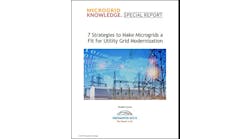Nanogrids versus Microgrids: Energy Storage a Winner in Both Cases
Nanogrids versus microgrids: Which one is likely to grow the largest market? Navigant’s Peter Asmus offers insight based on his recent research into world markets.
The business case for nanogrids echoes many of the same arguments used on behalf of microgrids. These smaller, modular, and flexible distribution networks are the antithesis of the bigger is better, economies of scale thinking that has guided energy resource planning over much of the past century. Nanogrids take the notion of a bottom-up energy paradigm to extreme heights. In some cases, nanogrids help articulate a business case that is even more radical than a microgrid; in other cases; nanogrids can peacefully coexist with the status quo.
Despite the bad news here at home coming from NRG, which has now has spun off its distributed solar PV business due to lagging sales, I believe the linking of batteries to distributed solar PV systems is a game changer. The recently published Solar PV plus Energy Storage Nanogrids report shows that this technology represents a less than $1 billion market worldwide today, but this number is expected to grow to $14 billion by 2024, with residential customers leading the market. When it comes to resilience, states such as Massachusetts have already signaled their preference for building-level solar PV plus energy storage nanogrids, since they face less regulatory hurdles than community resilience microgrids.
Ironically enough, the potential loss of federal investment tax credits for solar PV in the United States as early as 2016 and growing utility opposition globally to traditional solar PV support mechanisms such as net metering and feed-in tariffs only help to build the business case for solar PV plus energy storage nanogrids. Why? In order to extract the greatest value from solar PV in the absence of subsidy—whether that be utility demand charge abatement or greater reliability and resilience—will require linking this variable distributed generation to an energy storage system, either in the context of a microgrid or a nanogrid.
The intermittency of solar PV, which can be more extreme than wind on a second-by-second basis, has long been viewed as a drawback to widespread deployment as a substitute for 24/7 fossil fuel generation. Rooftop solar PV in particular can feature capacity factors as low as 20%. If such small systems—whose primary advantage for residential applications is providing financial benefits (offsetting expensive peak grid power)—are coupled with energy storage systems, the value of solar energy is magnified. In essence, it can be stored and then discharged during time periods most advantageous to asset owner. These same storage systems can also offer resiliency benefits when the larger grid goes down.
While the decline in solar PV pricing has been underway for quite some time, it is only recently that batteries—particularly lithium ion—have begun to match solar PV with a similar downward momentum, thereby increasing the appeal of this technology pairing.
The most radical interpretation of this solar PV plus energy storage nanogrid vision is at the residential level, the application where the nanogrid model is likely to meet opposition from utilities—that is, unless utilities begin offering nanogrid services. So far, utilities in Ontario, Australia, and New Zealand are doing just this (Powerstream, Vector and Ergon, respectively)
It is safe to say the size of the microgrid market is larger than that of nanogrid due to sheer scale. But microgrids also incorporate combined heat and power and wind, as well as other resources. If we narrowed the comparison to total capacity of just solar PV plus energy storage microgrids versus nanogrids, it is the smaller nanogrid that would likely come out on top today, and perhaps over the long term.
Credit: Navigant Research
This article originally appeared on the Navigant Research Blog. Author Peter Asmus is a principal research analyst at Navigant Research.







